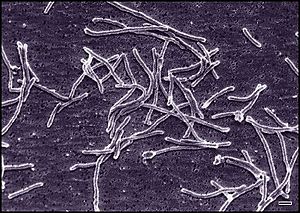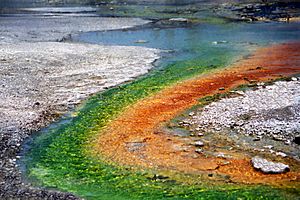Thermus aquaticus facts for kids
Quick facts for kids Thermus aquaticus |
|
|---|---|
 |
|
| Scientific classification | |
| Domain: | |
| Phylum: | |
| Class: | |
| Order: |
Thermales
|
| Family: |
Thermaceae
|
| Genus: |
Thermus
|
| Species: |
T. aquaticus
|
| Binomial name | |
| Thermus aquaticus Brock & Freeze, 1969
|
|
Thermus aquaticus is a special kind of bacteria that can live in very hot places. It's one of several "heat-loving" bacteria, also known as thermophiles. These bacteria belong to a group called Deinococcus–Thermus. Thermus aquaticus is famous because it provides a heat-resistant tool called Taq DNA polymerase. This tool is super important in molecular biology because it's used in a technique called polymerase chain reaction (PCR). PCR helps scientists make many copies of DNA.
Contents
Discovering Thermus aquaticus
In the 1960s, scientists started studying living things in hot springs. They first thought that bacteria couldn't survive in temperatures hotter than about 55°C (131°F). But soon, they found many bacteria in different hot springs that not only survived but actually grew well in much higher temperatures!
In 1969, two scientists, Thomas D. Brock and Hudson Freeze, found a new type of heat-loving bacteria. They named it Thermus aquaticus. This bacterium was first found in Mushroom Spring in Yellowstone National Park in the USA. Since then, it has been found in similar hot places all over the world.
How T. aquaticus Lives
T. aquaticus grows best when the temperature is between 65–70°C (149–158°F). But it can survive in temperatures from 50–80°C (122–176°F). This bacterium mostly eats proteins it finds in its environment. It has many special tools to break down proteins and move smaller pieces into its cells.
T. aquaticus is a chemotroph. This means it makes its own food using chemical reactions, a process called chemosynthesis. Sometimes, it lives near other bacteria called cyanobacteria that make food using sunlight (photosynthesis). T. aquaticus can then get energy from their photosynthesis. Usually, T. aquaticus uses oxygen to breathe, but one type, called Thermus aquaticus Y51MC23, can grow even without oxygen.
The genetic material of T. aquaticus includes one main part called a chromosome and four smaller parts called plasmids. Scientists have studied its complete genetic code. They found special genes called CRISPR genes in many places.
What T. aquaticus Looks Like
Thermus aquaticus usually looks like a cylinder or a rod. It's about 0.5 to 0.8 micrometers wide. A shorter rod shape is about 5 to 10 micrometers long. The longer, thread-like shape can be much longer, sometimes more than 200 micrometers.
These rod-shaped bacteria often group together. When many of them gather, they can form round shapes called "rotund bodies." These bodies are about 10 to 20 micrometers wide. Scientists used to think these bodies were made of cell parts, but they are actually made from the cell wall. We don't know exactly what these rotund bodies do. But scientists think they might store food or genetic material. They might also help the bacteria stick together and form colonies.
Special Tools from T. aquaticus
T. aquaticus is famous for its special enzymes that can work in high temperatures. The most well-known is the Taq DNA polymerase, which we'll talk about below.
Aldolase Enzyme
When scientists first started studying this heat-loving bacterium, they wanted to understand how its enzymes could work in such hot temperatures. Most enzymes stop working when it gets too hot. In 1970, scientists Freeze and Brock found a heat-stable enzyme called aldolase from T. aquaticus.
RNA Polymerase Enzyme
In 1974, the first polymerase enzyme found from T. aquaticus was an RNA polymerase. This enzyme is used in a process called transcription, which helps make copies of genetic information.
Taq I Restriction Enzyme
Many scientists who work with molecular biology learned about T. aquaticus in the late 1970s or early 1980s. This was because useful restriction endonucleases were found in this bacterium. These enzymes are like tiny scissors that cut DNA at specific spots. The name Taq comes from the way these enzymes are named. Scientists use a short name from the genus and species of the organism where the enzyme was found. So, Thermus aquaticus became Taq.
DNA Polymerase ("Taq pol")
The special DNA polymerase from T. aquaticus was first found in 1976. One great thing about this enzyme is that it can handle high temperatures. It works best at 72°C (162°F) and doesn't break down even at 95°C (203°F). This made it easier to get a pure form of the enzyme.
Later, a scientist named Kary Mullis and others found that this enzyme could be used in the polymerase chain reaction (PCR) process. PCR is a way to make many copies of short pieces of DNA. Before Taq polymerase, scientists had to add new enzymes after every heating step in PCR. But with Taq polymerase, they didn't need to, because it could survive the heat!
This enzyme was also copied, studied, and made in large amounts to be sold. In 1989, Science magazine called Taq polymerase its first "Molecule of the Year." In 1993, Kary Mullis won the Nobel Prize in Chemistry for his work with PCR.
Other Useful Enzymes
Because T. aquaticus works best at high temperatures, scientists can study reactions under conditions where other enzymes would stop working. Other enzymes found in this organism include DNA ligase, alkaline phosphatase, NADH oxidase, isocitrate dehydrogenase, amylomaltase, and fructose 1,6-disphosphate-dependent L-lactate dehydrogenase.
See also
 In Spanish: Thermus aquaticus para niños
In Spanish: Thermus aquaticus para niños


